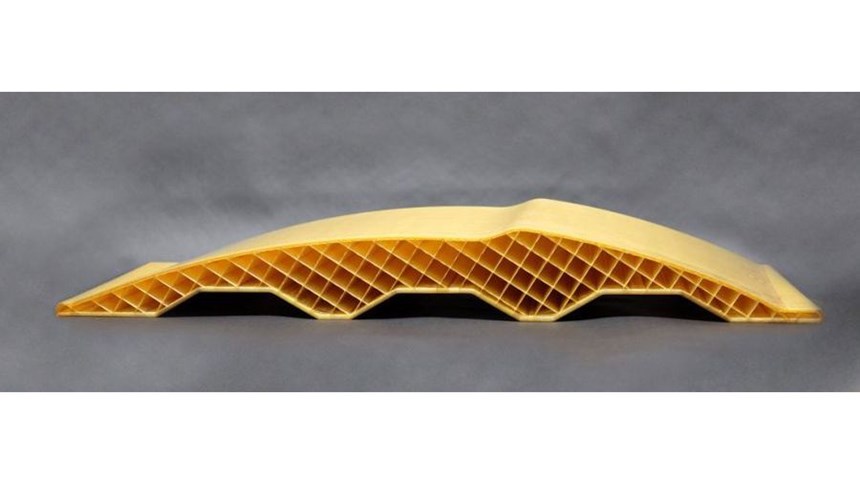Design Guide For Fdm Composite Tooling
3D printing is becoming more common in the aerospace tooling realm. Production tooling can be made quickly and on-demand, which helps the tooling industry keep pace with accelerating composite part design cycles and demand for faster overall part processing speeds.
#composites #polymer

Stratasys is introducing a new sacrificial 3D-printed tooling solution, displayed at Rapid and SAMPE Long Beach 2016.

This Ultem 1010 tool for Dassault can stand up to autoclave pressures and cure temperatures.
Previous Next

About a year ago I wrote an article in CW magazine about how 3D printing is becoming more common in the aerospace tooling realm. Fixtures, prototyping tools and even production tooling can be made quickly and on-demand, which helps the tooling industry keep pace with accelerating composite part design cycles and demand for faster overall part processing speeds. CW is seeing many examples of this. (For one, see this blog post by Jeff Sloan about Oak Ridge National Laboratory [ORNL] and its progress in this area.)
Stratasys shared solid evidence of this tooling trend during Rapid and SAMPE Long Beach earlier this year. Tim Schniepp, who is the Composites Tooling director at Stratasys, shared some insight with me regarding projects his company is involved with. The first is a 3D-printed sacrificial or trapped tooling solution. Using a new material that the company calls ST-130 together with a patent-pending "alternative fill" printing pattern, the trapped, washout tooling is designed for rapid build speed, fast dissolution, and high quality that can be autoclaved. The material and process were used to create a tool for Swift Engineering that allowed production of a complex hollow engine inlet duct (see the first photo above). The president of Swift Engineering, Rick Heise, says "Stratasys-produced composite tools allow us to develop products much faster without compromising quality or performance of the parts."
Secondly, Stratasys has launched a comprehensive design guide, entitled "Design Guide for FDM Composite Tooling," that lays out the best practices for design, fabrication and preparation of 3D printed composite tools that can be used to cure composites at temperatures exceeding 350°F and pressures of 100 psig, says Schniepp, when Ultem1010 resin material (supplied by SABIC, Pittsfield, Massachussetts) is used for the build (FDM is fused deposition modeling). Stratasys 3D-printed composite tooling using Ultem1010 enables manufacturers to produce high temperature (greater than 350°F), autoclave-cured composite structures in a fraction of the of time that traditional metal tools require, while also providing significant cost savings. Schniepp presented a technical paper at SAMPE regarding the design guide, entitled "Design Guide Development for Additive Manufacturing of Composite Tooling."
"We developed the Design Guide to provide our customers with the ability to immediately realize the immense time and cost-saving benefits of FDM composite tooling without the effort and expense required to develop the knowledge independently," says Schniepp.
To further assist customers, Schniepp says that Stratasys now offers an Acceleration Kit for its Fortus 900 printing machines, aimed at producing large tools. A larger extrusion tip and upgraded software package allows faster material laydown rate for faster builds. The acceleration kit is intended for Ultem1010 and ASA polymer materials.
This article originally appeared on CompositesWorld.com
RELATED CONTENT
-
Where Blockchain and 3D Printing Converge, Distributed Manufacturing Can Thrive
Decentralizing production through additive manufacturing can bring numerous benefits, but these can only be realized through trust. VeriTX is building a platform to secure a trusted digital supply chain for aerospace and beyond.
-
Wire Arc Additive Manufacturing Delivers Low Buy-To-Fly Ratios
Manufacturers in the aerospace industry buy expensive raw material with one common goal: to make it fly. To reduce its buy-to-fly ratio (the ratio of material inputs to final part output), this company turned to wire arc additive manufacturing to create near-net shape parts.
-
The Cool Parts Show, Episode 1: This Rocket Fuel Injector Is a Solid Part That Contains a Working Motor
Our new video series debuts with a look at a solid metal part made through additive manufacturing that was built with a motor embedded inside. The motor sealed within the part adjusts the rocket's fuel mixture while the rocket is in flight.
Design Guide For Fdm Composite Tooling
Source: https://www.additivemanufacturing.media/articles/using-3d-printing-for-composite-molds-and-tools-the-trend-continues-%282%29
Posted by: yeagerfamery.blogspot.com

0 Response to "Design Guide For Fdm Composite Tooling"
Post a Comment